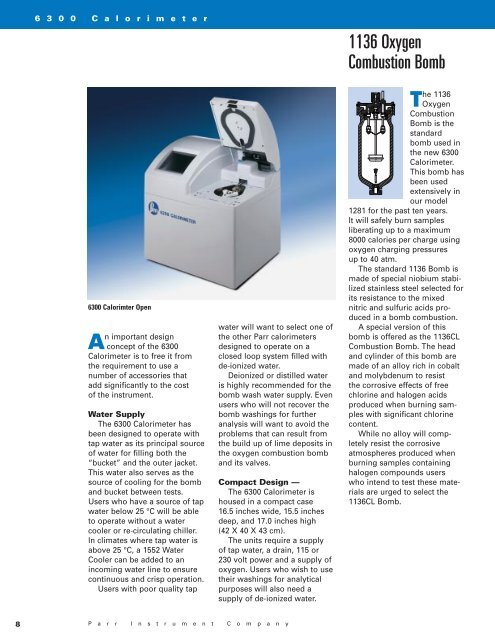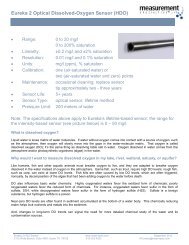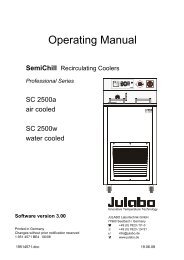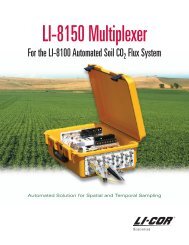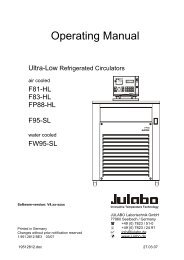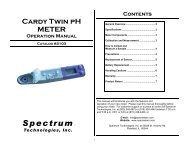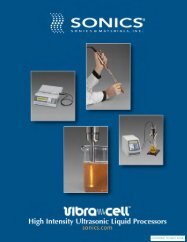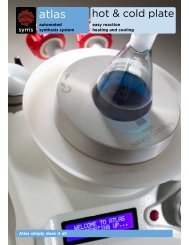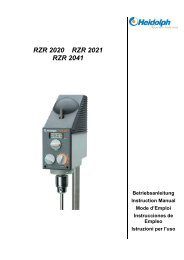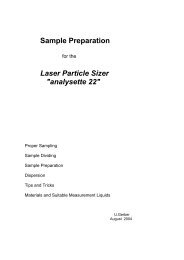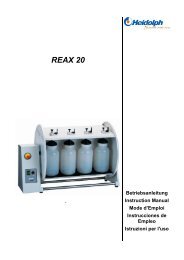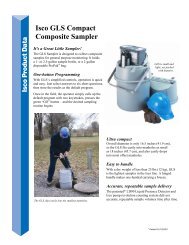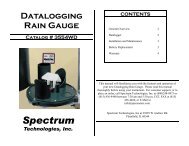6300 Automatic Isoperibol Calorimeter - ROFA Praha sro
6300 Automatic Isoperibol Calorimeter - ROFA Praha sro
6300 Automatic Isoperibol Calorimeter - ROFA Praha sro
Create successful ePaper yourself
Turn your PDF publications into a flip-book with our unique Google optimized e-Paper software.
6 3 0 0 C a l o r i m e t e r<br />
<strong>6300</strong> Calorimter Open<br />
An important design<br />
concept of the <strong>6300</strong><br />
<strong>Calorimeter</strong> is to free it from<br />
the requirement to use a<br />
number of accessories that<br />
add significantly to the cost<br />
of the instrument.<br />
Water Supply<br />
The <strong>6300</strong> <strong>Calorimeter</strong> has<br />
been designed to operate with<br />
tap water as its principal source<br />
of water for filling both the<br />
“bucket” and the outer jacket.<br />
This water also serves as the<br />
source of cooling for the bomb<br />
and bucket between tests.<br />
Users who have a source of tap<br />
water below 25 °C will be able<br />
to operate without a water<br />
cooler or re-circulating chiller.<br />
In climates where tap water is<br />
above 25 °C, a 1552 Water<br />
Cooler can be added to an<br />
incoming water line to ensure<br />
continuous and crisp operation.<br />
Users with poor quality tap<br />
water will want to select one of<br />
the other Parr calorimeters<br />
designed to operate on a<br />
closed loop system filled with<br />
de-ionized water.<br />
Deionized or distilled water<br />
is highly recommended for the<br />
bomb wash water supply. Even<br />
users who will not recover the<br />
bomb washings for further<br />
analysis will want to avoid the<br />
problems that can result from<br />
the build up of lime deposits in<br />
the oxygen combustion bomb<br />
and its valves.<br />
Compact Design —<br />
The <strong>6300</strong> <strong>Calorimeter</strong> is<br />
housed in a compact case<br />
16.5 inches wide, 15.5 inches<br />
deep, and 17.0 inches high<br />
(42 X 40 X 43 cm).<br />
The units require a supply<br />
of tap water, a drain, 115 or<br />
230 volt power and a supply of<br />
oxygen. Users who wish to use<br />
their washings for analytical<br />
purposes will also need a<br />
supply of de-ionized water.<br />
1136 Oxygen<br />
Combustion Bomb<br />
The 1136<br />
Oxygen<br />
Combustion<br />
Bomb is the<br />
standard<br />
bomb used in<br />
the new <strong>6300</strong><br />
<strong>Calorimeter</strong>.<br />
This bomb has<br />
been used<br />
extensively in<br />
our model<br />
1281 for the past ten years.<br />
It will safely burn samples<br />
liberating up to a maximum<br />
8000 calories per charge using<br />
oxygen charging pressures<br />
up to 40 atm.<br />
The standard 1136 Bomb is<br />
made of special niobium stabilized<br />
stainless steel selected for<br />
its resistance to the mixed<br />
nitric and sulfuric acids produced<br />
in a bomb combustion.<br />
A special version of this<br />
bomb is offered as the 1136CL<br />
Combustion Bomb. The head<br />
and cylinder of this bomb are<br />
made of an alloy rich in cobalt<br />
and molybdenum to resist<br />
the corrosive effects of free<br />
chlorine and halogen acids<br />
produced when burning samples<br />
with significant chlorine<br />
content.<br />
While no alloy will completely<br />
resist the corrosive<br />
atmospheres produced when<br />
burning samples containing<br />
halogen compounds users<br />
who intend to test these materials<br />
are urged to select the<br />
1136CL Bomb.<br />
8<br />
P a r r I n s t r u m e n t C o m p a n y


